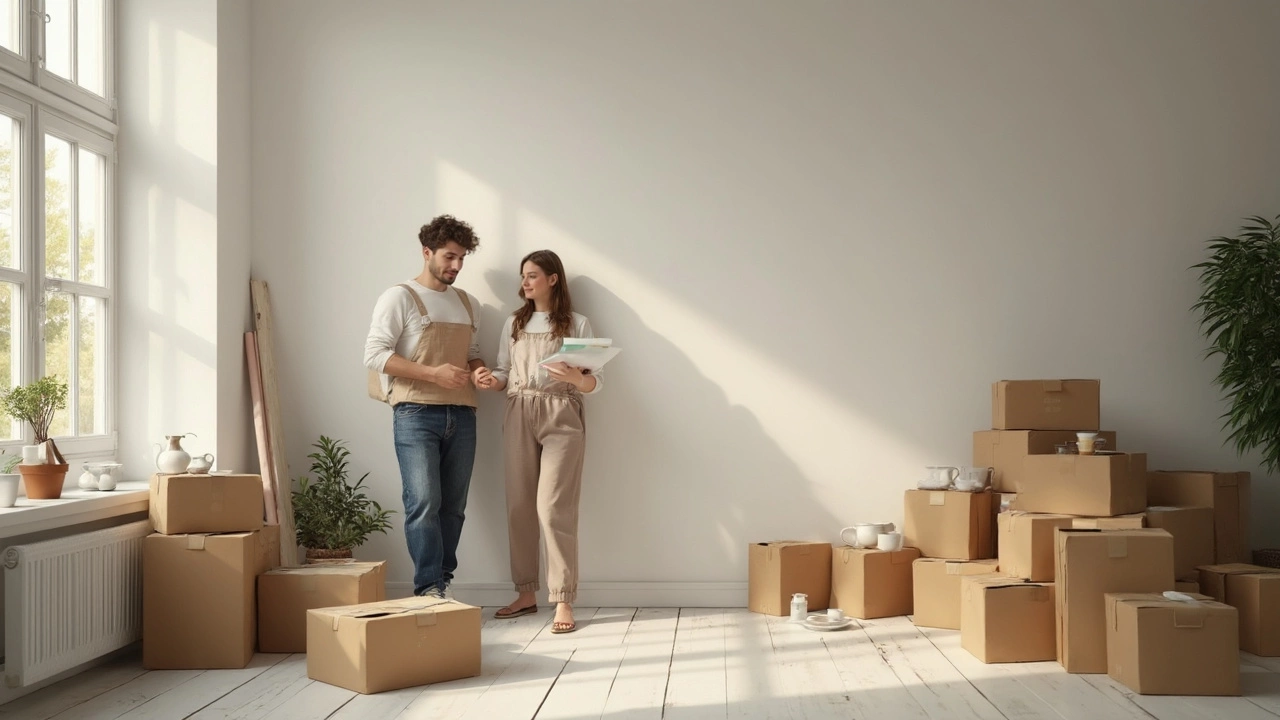Just snagged a brand-new home and itching to start decorating? Hold your horses. You might hear people say you’ve got to wait before picking up the paintbrush or tapping nails into the wall. It feels weird, right? You own the place, but it’s like there are invisible rules keeping you from making it yours.
There’s good reason for this, though. New builds look finished, but beneath that smooth plaster, the building is still drying out. Builders use a ton of water during construction—think wet plaster, concrete, even the adhesives. If you rush to decorate, paint and wallpaper won’t stick like they’re supposed to. You could end up with peeling, bubbling, or ugly stains. Even worse, trapped moisture can cause mold, and nobody wants that.
The trick is patience—and using the right techniques if you absolutely can’t wait. I’ll break down what’s happening with your walls, why builders and warranties matter, and how to sneak in personal touches without messing up your home’s finish. Ready to stop guessing and actually make your new build feel like yours? Let’s get into it.
- What Really Happens Inside Fresh Walls
- Warranties, Snags, and Builder Rules
- How to Make It Feel Like Yours (While You Wait)
- Best Time and Method to Start Decorating
What Really Happens Inside Fresh Walls
The inside of a new build looks all shiny and perfect, but it’s not as finished as it seems. Here’s what’s actually going on behind those spotless white walls: moisture—lots of it. When builders use wet trades like plaster, render, and concrete, they’re locking in gallons of water. On average, a three-bedroom house can hold more than 1,000 litres of water in its walls and floors after construction. No kidding.
This leftover moisture slowly moves out of the plaster and brickwork over weeks and even months. If you trap it inside with non-breathable paint or wallpaper, you’ll face problems like paint peeling and ugly water stains. Worst case, it can lead to black mold, which is a pain to fix and not great for your health.
Check out these typical drying-out timelines for new builds:
| Material/Area | Typical Drying Time |
|---|---|
| Fresh plaster | 3-6 weeks |
| Concrete floors | 1-2 months |
| Full house (all wet trades) | 6-12 months |
Let’s be real—opening windows to help the airflow makes a difference, but you can’t rush this process much more. If you start decorating too soon, you’re basically sealing all that moisture in. Every builder I’ve met has a story about someone who didn’t wait long enough and ended up having to strip wallpaper just a few months later.
So, before you pick up a roller, ask yourself: is it worth having your hard work ruined over a few weeks of patience? There are ways to keep things fresh without messing up the finish (I’ll cover them soon), but understanding how your home dries out is your first smart move.
Warranties, Snags, and Builder Rules
Here’s something nobody tells you when you first step into your new build—nearly every new build in the UK comes with a warranty, like an NHBC Buildmark or a Premier Guarantee. These aren’t just pieces of paper; they’re your insurance if things go wrong with the structure, fittings, or finishes in the first few years. Most of these warranties last at least 10 years, but the first two years are when you can flag up most snags, like cracks, sticking doors, or weird plumbing noises.
But here’s the catch: Jumping into decorating too soon (think painting, wallpapering, drilling, or changing fixtures) can void some parts of your warranty, especially if the builder thinks your DIY has made things worse. Most warranty providers and builders recommend you wait at least 9-12 months before major decorations. That gives all the materials time to properly dry, settle, and basically behave themselves.
“Carrying out home improvements too soon set against the drying-out process may make you liable for problems that would otherwise have been covered by the warranty,” says the NHBC, the UK’s biggest new home warranty provider.
Now, about snags—pretty much every new home has them, no matter how professional the builder. These might be chipped skirting boards, loose door handles, or paint splatters, and you’ve got a window (called the ‘snagging period’) to point these out. Most developers send in a team to fix them, but if you’ve decorated over a crack or stuck wallpaper over an issue, they might refuse repairs, blaming your changes.
- Snagging lists are usually accepted for up to 2 years after you move in.
- Warranty coverage for major structural issues runs for 10 years, but cosmetic fixes are only covered in the first 2 years.
- Any ‘unauthorized’ changes you make, like wall-mounting a TV or adding extra sockets, could let the builder off the hook for future fixes in those spots.
Here’s a quick breakdown so you’re not caught off guard:
| Item | Warranty Period | Risk If You Decorate Early |
|---|---|---|
| Cosmetic Snags | First 2 Years | May lose repair rights if covered or damaged by your work |
| Structural Issues | 10 Years | Still covered, unless changes caused the problem |
| Fixtures & Fittings | 1-2 Years | May void if replaced or tampered with |
This kind of small print sounds dull, but it’s a headache to fight for warranty repairs if you’ve gone rogue with your own decorating. Always check your warranty documents and builder’s handover pack before you touch anything major. Still want to paint? Ask your builder or warranty provider first. It saves countless arguments later.

How to Make It Feel Like Yours (While You Wait)
Waiting for walls to dry out doesn’t mean staring at bare rooms for months. There are simple, smart ways to put your stamp on your new build right away, without risking dodgy paint jobs or voiding any builder’s warranty.
First, focus on things that won’t mess with your walls. Think of adding personality through furniture, lighting, and soft furnishings. Grab a comfy sofa, a few eye-catching rugs, and some cozy throws. Change up the lighting—table lamps, floor lamps, even some plug-in wall lights can do wonders for atmosphere. You’d be surprised how much mood you can create with a couple of warm bulbs.
Your windows are begging for attention, so go wild with curtains or blinds. They instantly soften up any space and you can easily swap them later if your style changes. If you’re itching for art on the walls, consider freestanding frames or picture rails that don’t need nails. Big mirrors leaning against the wall also bounce light and make rooms feel bigger, plus they’re removable so no harm done.
Having a green thumb? Bring in houseplants. Snake plants, pothos, and even larger potted trees can add life and fresh air—no building work required. Plus, caring for plants gives you something to do while waiting on those walls.
Here’s a quick breakdown of easy ways to boost personality without risk:
- Layer area rugs for color and comfort underfoot
- Use removable adhesive hooks for light décor (just avoid heavy or irreplaceable items)
- Set up bookshelves or open storage to display stuff you love
- Opt for soft, moveable furniture like poufs or side tables
- Experiment with bedding and cushions for serious color pops
Builders often say it takes 6-12 months for fresh plaster to properly dry depending on weather and how the home is used (lots of showers or cooking can add moisture). Here’s a typical drying timeline:
| New Build Stage | Recommended Wait Time Before Decorating |
|---|---|
| Fresh plaster and paint | 6-12 months |
| External walls fully settled | Up to 12 months |
| Internal simple touch-ups (hooks, frames) | 3-6 months if using removable options |
If you own a pet like my cat Whiskers, set up a cozy corner for them too—a scratching post or padded bed says “home” to both of you. Whatever you do, keep things easy to move and change. It’s all about working with what you’ve got, not fighting the drying process. This way, your home feels like yours without having to repaint the whole place next year.
Best Time and Method to Start Decorating
You don’t have to just guess how long to wait before you can get out the paint rollers. For a typical new build, most builders recommend waiting at least six months before any serious decorating—especially if you’re thinking about using vinyl-based paints or wallpaper. This lets the building dry out properly, so you won’t end up with warped walls or bubbling finishes. In some cases, especially if it’s been a wet winter or the house was completed quickly, you might need to wait up to a year for everything to settle and dry out. You can always check with the site manager or your warranty documents to see what’s recommended for your home.
Wondering how long is “long enough”? You’ll often spot small cracks or hairline gaps in new plaster as it dries—totally normal. That’s your sign the house is still doing its thing. Wait until these stop appearing and the air in the house doesn’t feel damp; otherwise, you’re just asking for peeling paint and stains.
- Stick to breathable paints like basic emulsion for your first coat. Fancy, high-shine paints and papers can seal in moisture, which only makes things worse.
- If you notice condensation on windows, that’s another clue that things inside are still drying out. Use fans, keep windows open when you can, and don’t blast the heating all the time—it can make drying uneven.
- Want to hang pictures or shelves? Hold off until you’re sure the walls have settled. Nails or screws can damage plaster if it’s still shrinking or drying.
If you’re desperate to add some color or personality quickly, you can decorate with soft furnishings—rugs, curtains, cushions—or even stick-on wall decals that won’t damage paintwork. This gives you a chance to live in the home and see what feels right before breaking out the permanent stuff.
Once you’re good to go, do all your decorating in stages. Start with a mist coat—a watered-down emulsion paint—before going for the final colors. The mist coat helps seal new plaster but lets the walls breathe. Only then should you move on to full paint jobs or fancy wallpaper. Following the right order keeps your *new build* looking sharp and saves a lot of headaches later.
